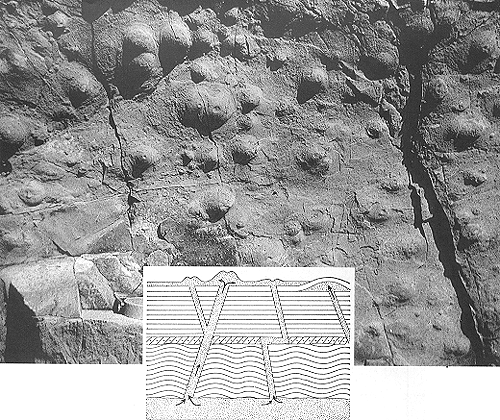
Injection structures: sand volcanoes
Plate 110

Injection structures: sand volcanoes
Plate 110
Sand volcanoes are moundlike structures whose diameter can vary from a few centimeters to several meters. They usually have a shallow central pit and less steep flanks than mud volcanoes. The last character obviously reflects the difference between the two sedimentary materials: sand is has no cohesion and has a smaller angle of repose than mud. Mud is so intimate a mixture of water and solid particles that it behaves as a fluid of its own, with its density and viscosity. Sand more rarely forms a single fluid phase with water; when it does, we say that it liquefies. Sand liquefaction requires particular circumstances: loose packing (which means hosting a lot of water in pores), fine grain size (increasing the surface to volume ratio, hence the surface in contact with water, and decreasing permeability), and some shaking (for example, by seismic waves transmitting stress to water). Liquefied sand, or quick sand, is squeezed out by the weight of overlying strata (overloading) and the internal pressure of pore water. Mud, in addition, can be pushed up by ascending gases.
The example illustrated here is found in Ancient turbidite deposits of the Hawick Rocks (Silurian of Scotland); identical Modern analogs have been described in a Modern tidal flat of the Arctic Canada by a sedimentologist endowed with a vivid imagination (he called them monroes ).
Sand volcanoes can occur on both subaerial and subaqueous interfaces. Consequently, they are not environmental indicators.
Injection and fluid escape structures can be caused by earthquake shocks, but not necessarily so. It is not correct, therefore, to call them seismites, because this means assuming a univocal, deterministic link between cause and effect. Instead, one should make the hypothesis that this link exists on a case by case basis. This implies considering other, independent evidence in favor of seismic events. At the moment, there are no safe criteria to identify with certainty earthquake-produced structures in the fossil record. Sedimentary and other external mechanisms, acting alone, can account for fluidization, liquefaction and related phenomena, as will be exemplified by the illustrations that follow.
Seismite is a genetic term, and should not be employed for describing deformational structures (and less so, whole beds and depositional units). Only when the object has been discussed and interpreted, can a genetic term be proposed, being conscious that other interpretations are possible and that the preferred one is subject to confutation.
| Photo: E. K. Walton 1970. |